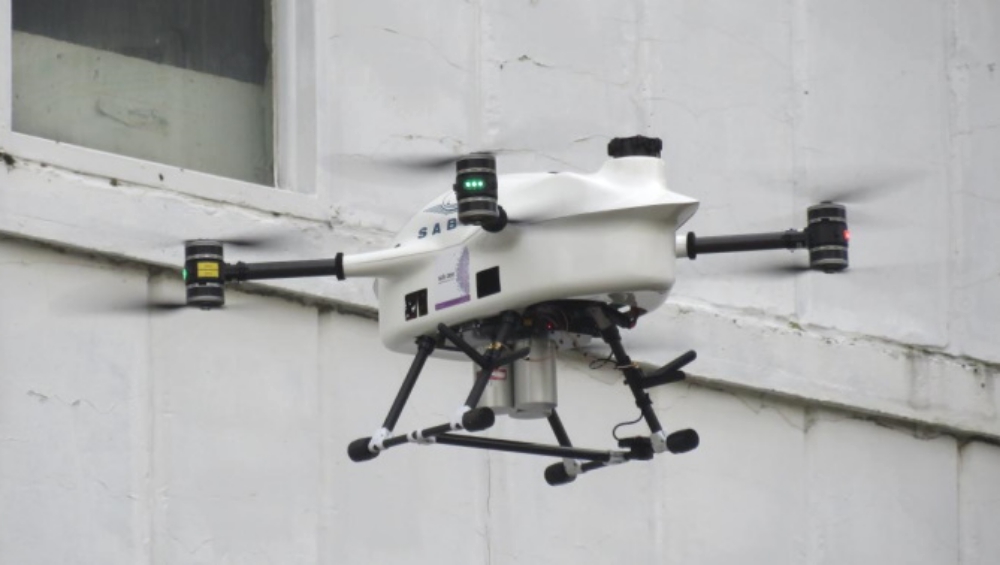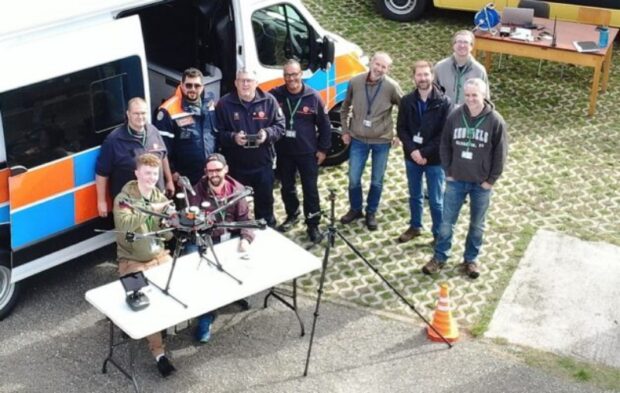Test flights of drones fitted with equipment to identify and measure the radiation being emitted from a plume source have been conducted at the Mol site of Belgium’s Nuclear Research Centre (SCK-CEN). Further tests flights are planned for later this year to prove a new, precise measurement technique.
In October last year, a team from Canadian Nuclear Laboratories (CNL) conducted a major drone testing campaign at the BR-1 reactor at Mol as part of a collaboration with SCK-CEN. More than simply airborne plume tracking and measurement, this project explored using drones to identify and measure the radiation being emitted from the plume source.
This campaign was specifically about testing how a shielded, upward-facing gamma spectrometer can be used to monitor the quantity of radioactivity being emitted during an incident, including individual isotopes, by flying transects (predetermined routes) which cross the plume from underneath. The BR-1 reactor was used because it emits an argon-41 plume from its stack during normal operation. These plumes can be picked up by radiation detectors, providing information which could be invaluable to emergency response teams during an accident, and to the recovery team after the initial emergency.
The sensor package – including a Kromek Sigma50 gamma spectrometer and CNL-designed tungsten collimator – were flown by the Belgian civil protection agency on their drone’s platform. CNL said its contribution to this collaboration lies in the customised detection equipment, flight plan development, and interpretation of the results.
CNL noted that measurement of plumes has been done with drones many times in the past, but this was an opportunity to enhance the practices, technologies and results being gathered.
“To do this we need to precisely pinpoint the data (dose) that is being received by the gamma spectrometer and identify where it is coming from,” said CNL research scientist Luke Lebel. “This is where the collimator comes in. The idea was to use the dose measurements we were collecting to directly estimate the rate of radionuclide release rate from the source.”
A collimator is a device which filters a stream of rays so that only those traveling parallel to a specified direction are allowed through. In this case, a specially designed collimator was used which allows only those gamma rays travelling in a particular direction (parallel to the collimator axis) to pass through. All other rays would be absorbed by the tungsten collimator. This collimator, when paired with a precise flight path, enabled the team to build a very accurate understanding of the source of the plume.
James Carr, a Research Scientist with Mechanical Equipment Development (MED) explains further:
“Collimating the shielded sensor essentially means we control what and how the sensor’s crystal “sees” by limiting its exposure. (Imagine looking through a paper towel roll.) In this case, we’ve designed the setup to fit around our existing UAV mounted gamma spectrometer. The unit also has a swappable collimator plug to let us experiment with the viewing angle parameters. We went through extensive iterative prototyping and took full advantage of Mechanical Equipment Design (MED)’s 3D printing and machining services.
“Beyond the shielded/collimated sensor, MED also designed and implemented the electronics and software to support interfacing with the system. Computational Techniques assisted with the software algorithm to generate the preprogrammed flight paths and CNL’s B750 manufacturing services assisted in machining the tungsten components.”
The reason for an upward facing sensor? While technically, we could collect collimated data from any direction outside the plume, an upward facing sensor, flown below the plume, allows the team to simplify variables used to calculate the source term of the release.
The execution of these field trials by staff in the MED branch was a major achievement in the Safety & Security theme area of the Federal Nuclear Science and Technology Work Plan and the start of a very positive new relationship of Belgian-Canadian scientific exchange.
More precise measurements
In May 2021, SCK-CEN and the Belgian aeronautical firm Sabca announced the development of drones fitted with scintillation counters to be used to carry out radiological measurements. At that time, SCK-CEN and Sabca anticipated the nuclear sector would soon be able to rely upon the assistance of these unmanned aircraft, which could be used as part of a monitoring programme, or during decommissioning projects or emergency planning, to carry out radiological measurements without any human intervention.
In December last year, the partners made the first extensive test flight of the ‘X-8 multicopter drone’, which is equipped with three rugged caesium iodide scintillation detectors. During the test flight, it mapped radiation levels over the BR3 reactor at Mol. SCK-CEN noted that although the reactor has largely been decommissioned, structures that emit ionising radiation are still present.
“The ideal place to test the drones as well as detectors is our own site,” said SCK-CEN researcher Geert Olyslaegers. “We know the radiological situation on our domain very well, which makes it easy for us to calibrate the detectors and fully adjust the measurements from the air.”
The test flight on 7 December was successful. The combination of detectors and drone identified the radioactive source, qualified and quantified the radiation and produced a special visualisation of the contamination.

The X-8 multicopter in action at the BR3 site – Image: SCK-CEN
Later this year, a test flight will be carried out of the entire Mol site using a fixed wing drone.
“That flight will be the test for our drone, which has to complete long measurement flights,” said Olyslaegers. “On its return, all measurement results must match exactly the values we obtain via other radiological measuring instruments.”
The technology is being developed under the BUDDAWAK research project, an innovative project on the use of drones which is funded by the Energy Transition Fund of the FPS Economy.
“Upon completion of the research project, industry and government can rely on the unique detector system in the drones,” SCK-CEN said. “Its industrial applicability is particularly valuable in the context of decommissioning operations or surveillance programmes in and around nuclear facilities. Admittedly, many measurement technologies already exist to map radiological situations or to monitor sites more rigorously, but drones significantly increase the efficiency, frequency and spatial visibility of those measurements.”
“Above all, there is no longer any need for human intervention in high-risk areas, so you protect yourself at all times while being able to measure much longer, cheaper and better,”
according to Olyslaegers.

